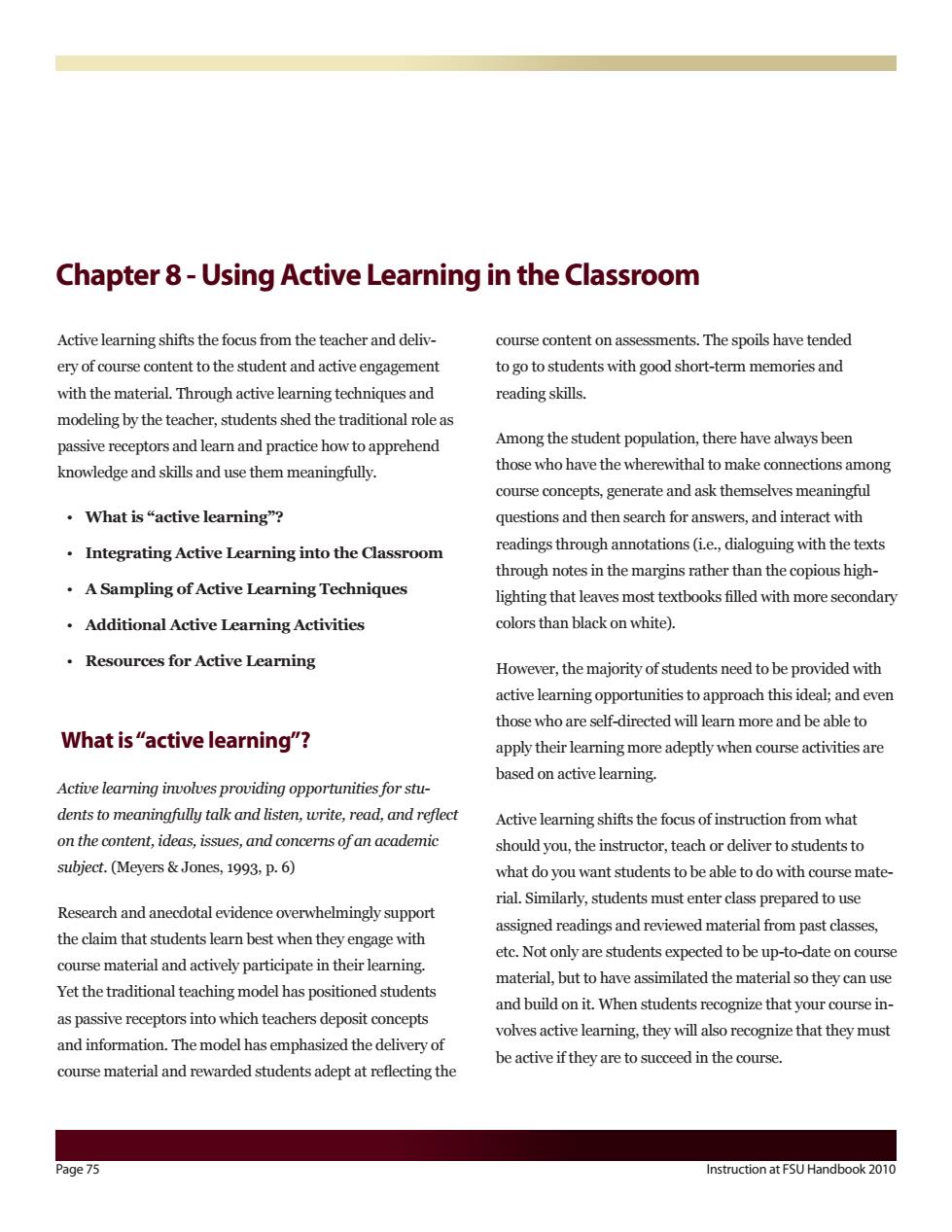正在加载图片...

Chapter 8-Using Active Learning in the Classroom Active learning shifts the focus from the teacher and deliv- course content on ass ssments.The spoils have tended ery of course content to the student and active engagement to go to students with good short-term memories and with the material Through active learning techniques and reading skills. modeling by the teacher,students shed the traditional role as passive receptors and learn and practice how to apprehend Among the student population,there have always been knowledge and skills and use them meaningfully. those who have the wherewithal to make connections among course concepts,generate and ask themselves meaningful 。Vhat is“active learning"? questions and then search for answers,and interact with Integrating Active Learning into the Classroom readings through annotations(i.e.,dialoguing with the texts through notes in the margins rather than the copious high- A Sampling of Active Learning Techniques lighting that leaves most textbooks filled with more secondary Additional Active Learning Activities colors than black on white). Resources for Active Learning However,the majority of students need to be provided with active learning opportunities to approach this ideal;and ever those who are self-directed will learn more and be able to What is"active learning"? apply their learing more adeptly when based on active learning. Active learning involves providing opportunities for stu- dents to meaningfully talk and listen,write,read,and reflect Active learning shifts the focus of instruction from what on the content.ideas.issues.and concerns of an academic should you,the instructor,teach or deliver to students to subject.(Meyers &Jones,1993,p.6) what do you want students to be able to do with course mate Research and anecdotal evidence overwhelmingly support rial.Similarly,students must enter class prepared to use the claim that students learn best when they engage with assigned readings and reviewed material from past classes, course material and actively participate in their learning. etc.Not only are students expected to be up-to-date on course Yet the traditional teaching model has positioned students material,but to have assimilated the material so they can use as passive which teachers deposit concepts and build on it.When students recognize that your course in- volves active learning.they will also recognize that they must and information.The model has emphasized the delivery of course material and rewarded students adept at reflecting the be active if they are to succeed in the course. nstruction at FSU Han Page 75 Instruction at FSU Handbook 2010 course content on assessments. The spoils have tended to go to students with good short-term memories and reading skills. Among the student population, there have always been those who have the wherewithal to make connections among course concepts, generate and ask themselves meaningful questions and then search for answers, and interact with readings through annotations (i.e., dialoguing with the texts through notes in the margins rather than the copious highlighting that leaves most textbooks filled with more secondary colors than black on white). However, the majority of students need to be provided with active learning opportunities to approach this ideal; and even those who are self-directed will learn more and be able to apply their learning more adeptly when course activities are based on active learning. Active learning shifts the focus of instruction from what should you, the instructor, teach or deliver to students to what do you want students to be able to do with course material. Similarly, students must enter class prepared to use assigned readings and reviewed material from past classes, etc. Not only are students expected to be up-to-date on course material, but to have assimilated the material so they can use and build on it. When students recognize that your course involves active learning, they will also recognize that they must be active if they are to succeed in the course. Active learning shifts the focus from the teacher and delivery of course content to the student and active engagement with the material. Through active learning techniques and modeling by the teacher, students shed the traditional role as passive receptors and learn and practice how to apprehend knowledge and skills and use them meaningfully. • What is “active learning”? • Integrating Active Learning into the Classroom • A Sampling of Active Learning Techniques • Additional Active Learning Activities • Resources for Active Learning What is “active learning”? Active learning involves providing opportunities for students to meaningfully talk and listen, write, read, and reflect on the content, ideas, issues, and concerns of an academic subject. (Meyers & Jones, 1993, p. 6) Research and anecdotal evidence overwhelmingly support the claim that students learn best when they engage with course material and actively participate in their learning. Yet the traditional teaching model has positioned students as passive receptors into which teachers deposit concepts and information. The model has emphasized the delivery of course material and rewarded students adept at reflecting the Chapter 8 - Using Active Learning in the Classroom